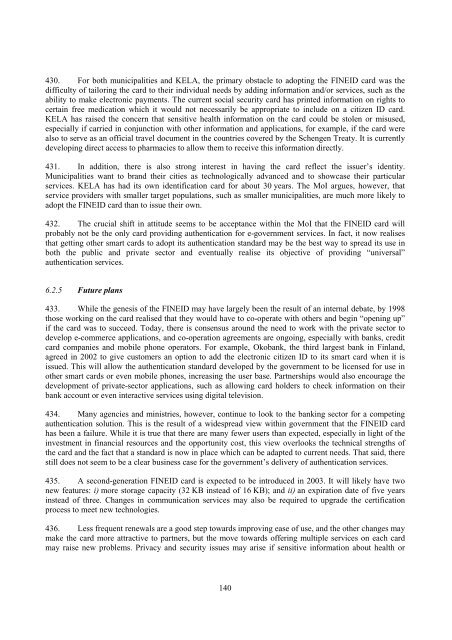e-GOVERNMENT IN FINLAND - ePractice.eu
e-GOVERNMENT IN FINLAND - ePractice.eu
e-GOVERNMENT IN FINLAND - ePractice.eu
You also want an ePaper? Increase the reach of your titles
YUMPU automatically turns print PDFs into web optimized ePapers that Google loves.
430. For both municipalities and KELA, the primary obstacle to adopting the F<strong>IN</strong>EID card was the<br />
difficulty of tailoring the card to their individual needs by adding information and/or services, such as the<br />
ability to make electronic payments. The current social security card has printed information on rights to<br />
certain free medication which it would not necessarily be appropriate to include on a citizen ID card.<br />
KELA has raised the concern that sensitive health information on the card could be stolen or misused,<br />
especially if carried in conjunction with other information and applications, for example, if the card were<br />
also to serve as an official travel document in the countries covered by the Schengen Treaty. It is currently<br />
developing direct access to pharmacies to allow them to receive this information directly.<br />
431. In addition, there is also strong interest in having the card reflect the issuer’s identity.<br />
Municipalities want to brand their cities as technologically advanced and to showcase their particular<br />
services. KELA has had its own identification card for about 30 years. The MoI argues, however, that<br />
service providers with smaller target populations, such as smaller municipalities, are much more likely to<br />
adopt the F<strong>IN</strong>EID card than to issue their own.<br />
432. The crucial shift in attitude seems to be acceptance within the MoI that the F<strong>IN</strong>EID card will<br />
probably not be the only card providing authentication for e-government services. In fact, it now realises<br />
that getting other smart cards to adopt its authentication standard may be the best way to spread its use in<br />
both the public and private sector and eventually realise its objective of providing “universal”<br />
authentication services.<br />
6.2.5 Future plans<br />
433. While the genesis of the F<strong>IN</strong>EID may have largely been the result of an internal debate, by 1998<br />
those working on the card realised that they would have to co-operate with others and begin “opening up”<br />
if the card was to succeed. Today, there is consensus around the need to work with the private sector to<br />
develop e-commerce applications, and co-operation agreements are ongoing, especially with banks, credit<br />
card companies and mobile phone operators. For example, Okobank, the third largest bank in Finland,<br />
agreed in 2002 to give customers an option to add the electronic citizen ID to its smart card when it is<br />
issued. This will allow the authentication standard developed by the government to be licensed for use in<br />
other smart cards or even mobile phones, increasing the user base. Partnerships would also encourage the<br />
development of private-sector applications, such as allowing card holders to check information on their<br />
bank account or even interactive services using digital television.<br />
434. Many agencies and ministries, however, continue to look to the banking sector for a competing<br />
authentication solution. This is the result of a widespread view within government that the F<strong>IN</strong>EID card<br />
has been a failure. While it is true that there are many fewer users than expected, especially in light of the<br />
investment in financial resources and the opportunity cost, this view overlooks the technical strengths of<br />
the card and the fact that a standard is now in place which can be adapted to current needs. That said, there<br />
still does not seem to be a clear business case for the government’s delivery of authentication services.<br />
435. A second-generation F<strong>IN</strong>EID card is expected to be introduced in 2003. It will likely have two<br />
new features: i) more storage capacity (32 KB instead of 16 KB); and ii) an expiration date of five years<br />
instead of three. Changes in communication services may also be required to upgrade the certification<br />
process to meet new technologies.<br />
436. Less frequent renewals are a good step towards improving ease of use, and the other changes may<br />
make the card more attractive to partners, but the move towards offering multiple services on each card<br />
may raise new problems. Privacy and security issues may arise if sensitive information about health or<br />
140
















